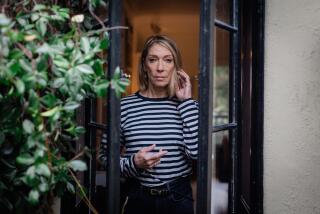Joni Gordon dies at 75; Newspace gallery owner nurtured L.A. art
Joni Gordon, an art world novice who bought a failing Melrose Avenue gallery, Newspace, 37 years ago and turned it into an incubator for Los Angeles’ contemporary art scene, has died. She was 75.
Gordon died Sept. 11 in Bend, Ore., 10 days after a massive brain hemorrhage at her central Oregon vacation home, said her son, John.
Under Gordon, Newspace, which she ran from 1975 to 2006, became known for nurturing emerging local talent, including early shows for photographer Judy Fiskin, conceptual artist Robert Cumming, and painters Martha Alf, Jeff Price, John Sonsini, Lisa Adams and Dan McCleary.
She also showed the work of Betty Parsons, who blossomed as an artist after championing the giants of Abstract Expressionism as a legendary New York dealer.
“She really did show a lot of interesting and quite amazing artists over the years,” said Carol S. Eliel, curator of modern art at the Los Angeles County Museum of Art. “She had quite an eye and was able to pick them out of a crowd when others hadn’t started focusing on them yet.”
In 2006, when she was 70, Gordon decided to close the gallery but remain active as a dealer of previously owned art works. Her iconoclastic taste was evident in the last show: Called “Good to Go,” it was a survey of four decades of Newspace exhibitions that ranged from Price’s first bronze sculptures to Frederick Wight’s visionary landscapes.
Artists such as Alf praised Gordon’s dedication and nurturing attitude. “It’s strange — she’s younger than I am,” Alf, 82, said this week, “but I always felt she was like my mother. She just had that quality.”
Although she had no formal art training, Gordon began working in galleries while an undergraduate at UCLA in the late 1950s. During the 1960s and early ‘70s she ran an art salon from her home, hosting speakers such as sculptor Edward Kienholz and painter Vija Celmins and leading tours of artists’ studios.
In 1975 she was organizing artists’ books at the Los Angeles Institute of Contemporary Art, a nonprofit space she helped found, when her research took her to Newspace, a cooperative gallery on an unfashionable stretch of Melrose that had been launched a few years earlier by art students from UC Irvine. It was being run by Jean St. Pierre, a painter.
St. Pierre had agreed to loan Gordon books by performance artist Chris Burden. But when Gordon arrived at the gallery, she found St. Pierre and Newspace on the verge of collapse from serious financial troubles. After a long conversation, she agreed to take over the gallery and its debts.
She was not a wealthy person, but the price was right: 26 cents for the key and $200 for the rent.
“I went in ostensibly to borrow these books,” Gordon said in a 2002 oral history for the Smithsonian Institution’s Archives of American Art, “and I walked out owning the gallery.”
A few days later Gordon reopened Newspace with a show of St. Pierre’s white paintings and sold every one.
One of her earliest clients was New York playwright Edward Albee, who arrived unannounced in a cab in 1976 and bought a 10-foot-tall concrete sculpture from Christopher Georgesco’s first show.
“She was intelligent, sensitive and ... much more aesthetic than commercial,” Albee said this week, “but she knew what she was doing. She had a very good mind and a very good eye.”
Albee introduced Gordon to Parsons, who became Gordon’s mentor. Gordon also cited Betty Asher, the Los Angeles contemporary art collector and dealer, as an important influence.
Gordon was born Joan Toffler in Cleveland on Sept. 24, 1936. Her parents divorced when she was an infant, and in 1946 she moved to California with her mother and stepfather. When her stepfather died in 1948, her mother sold cosmetics in a department store to support them.
As a teenager in West L.A., Gordon was interested in acting and starred in productions at Emerson Junior High, where Robert Redford was a classmate. After graduating from University High in 1954, she entered UCLA, where she majored in English and minored in anthropology.
Gordon found herself drawn to the painting studios, which were housed in the same building as the anthropology collections. Observing art students such as Celmins and Richard Diebenkorn as they worked was, she said in the oral history, “unbelievable to me. That a university would nurture artists. I didn’t even know you could study art history.”
To buy art, she began saving a portion of her allowance and meager earnings as a department store wrapper. She continued to add to the collection that fills every nook and cranny of her Los Angeles home until shortly before she died, buying collages from a 23-year-old New York artist during a visit with Albee in August.
“I knew I had no interest in … making art, but I had the sincere desire to be near it — and you could only do that,” she once told The Times, “if you owned it.”
In addition to her son, she is survived by her husband of 54 years, Monte, and two grandchildren.
More to Read
Start your day right
Sign up for Essential California for the L.A. Times biggest news, features and recommendations in your inbox six days a week.
You may occasionally receive promotional content from the Los Angeles Times.







